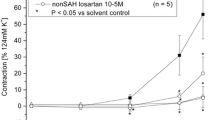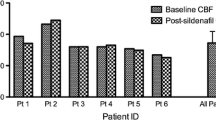Abstract
Background
Vasopressor-induced hypertension is routinely indicated for prevention and treatment of cerebral vasospasm (CVS) after subarachnoid haemorrhage (SAH). Mechanisms underlying patients’ clinical improvement during vasopressor-induced hypertension remain incompletely understood. The aim of this study was to evaluate angiographic effects of normovolaemic Norepinephrine (NE)-induced hypertension therapy on the rabbit basilar artery (BA) after SAH.
Methods
Cerebral vasospasm was induced using the one-haemorrhage rabbit model; sham-operated animals served as controls. Five days later the animals underwent follow-up angiography prior to and during NE-induced hypertension. Changes in diameter of the BA were digitally calculated in mean µm ± SEM (standard error of mean).
Findings
Significant CVS of 14.2% was documented in the BA of the SAH animals on day 5 compared to the baseline angiogram on day 0 (n = 12, p < 0.01), whereas the BA of the control animals remained statistically unchanged (n = 12, p > 0.05). During systemic administration of NE, mean arterial pressure increased from 70.0 ± 1.9 mmHg to 136.0 ± 2.1 mmHg in the SAH group (n = 12, p < 0.001) and from 72.0 ± 3.1 to 137.8 ± 1.3 in the control group (n = 12, p < 0.001). On day 5 after SAH, a significant dilatation of the BA in response to norepinephrine could be demonstrated in both groups. The diameter of the BA in the SAH group increased from 640.5 ± 17.5 µm to 722.5 ± 23.7 µm (n = 12, p < 0.05; ). In the control group the diameter increased from 716.8 ± 15.5 µm to 779.9 ± 24.1 µm (n = 12, p < 0.05).
Conclusion
This study demonstrated that NE-induced hypertension causes angiographic dilatation of the BA in the SAH rabbit model. Based on these observations, it can be hypothesised that clinical improvement during vasopressor-induced hypertension therapy after SAH might be explained with cerebral vasodilatation mechanisms that lead to improvement of cerebral blood flow.



Similar content being viewed by others
Abbreviations
- CVS:
-
Cerebral vasospasm
- SAH:
-
Subarachnoid haemorrhage
- NE:
-
Norepinephrine
- BA:
-
Basilar artery
- SEM:
-
Standard error of the mean
- MAP:
-
Mean arterial pressure
- DIND:
-
Delayed ischemic neurological deficits
- CBF:
-
Cerebral blood flow
- DSA:
-
Digital subtraction angiography
- HHH:
-
Haemodilution, hypervolaemia, induced hypertension
References
Awad IA, Carter LP, Spetzler RF, Medina M, Williams FC Jr (1987) Clinical vasospasm after subarachnoid haemorrhage: response to hypervolaemic haemodilution and arterial hypertension. Stroke 18:365–372
Darby JM, Yonas H, Marks EC, Durham S, Snyder RW, Nemoto EM (1994) Acute cerebral blood flow response to dopamine-induced hypertension after subarachnoid haemorrhage. J Neurosurg 80:857–864
Egge A, Waterloo K, Sjoholm H, Solberg T, Ingebrigtsen T, Romner B (2001) Prophylactic hyperdynamic post-operative fluid therapy after aneurysmal subarachnoid haemorrhage: a clinical, prospective, randomised, controlled study. Neurosurgery 49:593–605. discussion 605-596. doi:10.1097/00006123-200109000-00012
Fandino J, Sherman JD, Zuccarello M, Rapoport RM (2003) Cocaine-induced endothelin-1-dependent spasm in rabbit basilar artery in vivo. J Cardiovasc Pharmacol 41:158–161. doi:10.1097/00005344-200302000-00002
Fergusen S, Macdonald RL (2007) Predictors of cerebral infarction in patients with aneurysmal subarachnoid haemorrhage. Neurosurgery 60:658–667. discussion 667. doi:10.1227/01.NEU.0000255396.23280.31
Hoh BS, Ogilvy CS (2002) Risk of haemorrhage from unsecured, unruptured aneurysms during and after hypertensive hypervolaemic therapy. Neurosurgery 50:1207–1211. discussion 1211-1202. doi:10.1097/00006123-200206000-00006
Joseph M, Ziadi S, Nates J, Dannenbaum M, Malkoff M (2003) Increases in cardiac output can reverse flow deficits from vasospasm independent of blood pressure: a study using xenon computed tomographic measurement of cerebral blood flow. Neurosurgery 53(Joseph M, Ziadi S, Nates J, Dannenbaum M, Malkoff M):1044–1051 discussion 1051-1042
Kassell NF, Peerless SJ, Durward QJ, Beck DW, Drake CG, Adams HP (1982) Treatment of ischaemic deficits from vasospasm with intra-vascular volume expansion and induced arterial hypertension. Neurosurgery 11:337–343. doi:10.1097/00006123-198209000-00001
Kassell NF, Sasaki T, Colohan AR, Nazar G (1985) Cerebral vasospasm following aneurysmal subarachnoid haemorrhage. Stroke 16:562–572
Kosnik EJ, Hunt WE (1976) Post-operative hypertension in the management of patients with intracranial arterial aneurysms. J Neurosurg 45:148–154
Lang EW, Diehl RR, Mehdorn HM (2001) Cerebral auto-regulation testing after aneurysmal subarachnoid haemorrhage: the phase relationship between arterial blood pressure and cerebral blood flow velocity. Crit Care Med 29:158–163. doi:10.1097/00003246-200101000-00031
Lee KH, Lukovits T, Friedman JA (2006) “Triple-H” therapy for cerebral vasospasm following subarachnoid haemorrhage. Neurocrit Care 4:68–76. doi:10.1385/NCC:4:1:068
Lennihan L, Mayer SA, Fink ME, Beckford A, Paik MC, Zhang H, Wu YC, Klebanoff LM, Raps EC, Solomon RA (2000) Effect of hypervolaemic therapy on cerebral blood flow after subarachnoid haemorrhage : a randomised controlled trial. Stroke 31:383–391
Liu-Deryke X, Rhoney DH (2006) Cerebral vasospasm after aneurysmal subarachnoid haemorrhage: an overview of pharmacologic management. Pharmacotherapy 26:182–203. doi:10.1592/phco.26.2.182
Marbacher S, Neuschmelting V, Graupner T, Jakob SM, Fandino J (2008) Prevention of delayed cerebral vasospasm by continuous intrathecal infusion of glyceroltrinitrate and nimodipine in the rabbit model in vivo. Intensive Care Med 34:932–938. doi:10.1007/s00134-008-0995-x
Miller JA, Dacey RG Jr, Diringer MN (1995) Safety of hypertensive hypervolaemic therapy with phenylephrine in the treatment of delayed ischaemic deficits after subarachnoid haemorrhage. Stroke 26:2260–2266
Muench E, Horn P, Bauhuf C, Roth H, Philipps M, Hermann P, Quintel M, Schmiedek P, Vajkoczy P (2007) Effects of hypervolaemia and hypertension on regional cerebral blood flow, intracranial pressure, and brain tissue oxygenation after subarachnoid haemorrhage. Crit Care Med 35:1844–1851. quiz 1852. doi:10.1097/01.CCM.0000275392.08410.DD
Muizelaar JP, Becker DP (1986) Induced hypertension for the treatment of cerebral ischaemia after subarachnoid haemorrhage. Direct effect on cerebral blood flow. Surg Neurol 25:317–325. doi:10.1016/0090-3019(86) 90205-3
Naval NS, Stevens RD, Mirski MA, Bhardwaj A (2006) Controversies in the management of aneurysmal subarachnoid haemorrhage. Crit Care Med 34:511–524. doi:10.1097/01.CCM.0000198331.45998.85
Origitano TC, Wascher TM, Reichman OH, Anderson DE (1990) Sustained increased cerebral blood flow with prophylactic hypertensive hypervolaemic haemodilution (“triple-H” therapy) after subarachnoid haemorrhage. Neurosurgery 27:729–739. discussion 739-740. doi:10.1097/00006123-199011000-00010
Otsubo H, Takemae T, Inoue T, Kobayashi S, Sugita K (1990) Normovolaemic induced hypertension therapy for cerebral vasospasm after subarachnoid haemorrhage. Acta Neurochir (Wien) 103:18–26. doi:10.1007/BF01420187
Pluta RM (2005) Delayed cerebral vasospasm and nitric oxide: review, new hypothesis, and proposed treatment. Pharmacol Ther 105:23–56. doi:10.1016/j.pharmthera.2004.10.002
Raabe A, Beck J, Keller M, Vatter H, Zimmermann M, Seifert V (2005) Relative importance of hypertension compared with hypervolaemia for increasing cerebral oxygenation in patients with cerebral vasospasm after subarachnoid haemorrhage. J Neurosurg 103:974–981
Sen J, Belli A, Albon H, Morgan L, Petzold A, Kitchen N (2003) Triple-H therapy in the management of aneurysmal subarachnoid haemorrhage. Lancet Neurol 2:614–621. doi:10.1016/S1474-4422(03) 00531-3
Soehle M, Czosnyka M, Pickard JD, Kirkpatrick PJ (2004) Continuous assessment of cerebral auto-regulation in subarachnoid haemorrhage. Anesth Analg 98:1133–1139. table of contents. doi:10.1213/01.ANE.0000111101.41190.99
Solomon RA, Fink ME, Lennihan L (1988) Early aneurysm surgery and prophylactic hypervolaemic hypertensive therapy for the treatment of aneurysmal subarachnoid haemorrhage. Neurosurgery 23:699–704
Suzuki M, Asahara H, Endo S, Inada K, Doi M, Kuroda K, Ogawa A (1999) Increased levels of nitrite/nitrate in the cerebrospinal fluid of patients with subarachnoid haemorrhage. Neurosurg Rev 22:96–98. doi:10.1007/s101430050038
Treggiari MM, Walder B, Suter PM, Romand JA (2003) Systematic review of the prevention of delayed ischaemic neurological deficits with hypertension, hypervolaemia, and haemodilution therapy following subarachnoid haemorrhage. J Neurosurg 98:978–984
Yano K, Kuroda T, Tanabe Y, Yamada H (1993) Preventive therapy against delayed cerebral ischaemia after aneurysmal subarachnoid haemorrhage: trials of thromboxane A2 synthetase inhibitor and hyperdynamic therapy. Acta Neurochir (Wien) 125:15–19. doi:10.1007/BF01401822
Acknowledgments
This study was supported by the Cerebrovascular Research Fund from the Departments of Neurosurgery and Intensive Care Medicine (Account Nr. 34-160), University of Bern, and from an unrestricted grant from Actelion Ltd, Allschwil, Switzerland. We are grateful to and thank H.R. Widmer, PhD, J. Schmid, RN, and Mr. H. Rohrer from the Departments of Neurosurgery and Neuroradiology, Bern University Hospital, for their professional laboratory support.
Financial disclosure/Conflict of interest
None of the authors has any conflict of interest to declare.
Author information
Authors and Affiliations
Corresponding author
Additional information
Volker Neuschmelting and Ali-Reza Fathi contributed equally to the study.
Rights and permissions
About this article
Cite this article
Neuschmelting, V., Fathi, AR., Hidalgo Staub, E.T. et al. Norepinephrine-induced hypertension dilates vasospastic basilar artery after subarachnoid haemorrhage in rabbits. Acta Neurochir 151, 487–493 (2009). https://doi.org/10.1007/s00701-009-0287-4
Received:
Accepted:
Published:
Issue Date:
DOI: https://doi.org/10.1007/s00701-009-0287-4




